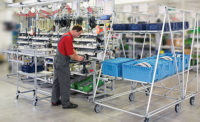Employees at Fiat Chrysler’s Indiana Transmission Plant I (ITPI) in Kokomo, IN, have achieved something few in manufacturing can claim—they have logged 10 million hours, or a span of more than three years, without a lost-time injury.
To achieve this milestone, the nearly 2,700 employees—including some 1,100 new hires—have made safety a priority. Employees proactively addressed potential hazards, improved working conditions, and focused on training to eliminate work-related injuries or illnesses that cause lost time from work beyond the day or shift when the incident occurred.
“This is something that’s never been done before,” says Brian Harlow, vice president for manufacturing at Fiat Chrysler. “The most important asset of any company is the people who perform the work. This record is a result of the commitment of the ITPI team to doing the right things to help control and eliminate safety hazards identified in the workplace. It is this teamwork that helped achieve the seemingly impossible.”
A focus on Fiat Chrysler’s World Class Manufacturing (WCM) system contributed significantly to achieving the milestone. WCM is a methodology that focuses on reducing waste, increasing productivity, and improving quality and safety in a systematic way. WCM engages the workforce to provide and implement suggestions on how to improve their jobs and their plants. WCM was first implemented by Fiat in 2006 and introduced to Chrysler Group as part of the alliance between the two companies in June 2009.
Through the implementation of WCM and employee suggestions, ITPI identified more than 5,000 opportunities to improve safety. Suggestions included conducting ergonomic assessments to analyze each job for hazards; delivering parts to the “golden zone” (the area immediately in front of the operator); and designing machines with “dry floor guarding” to keep fluids from leaking and creating slip hazards.
“Safety is a mindset,” says Jeremy Keating, ITPI plant manager. “Increasing productivity [and] emphasizing safety requires everyone to remain committed to safety by proactively improving the process and work conditions. It is our job to make sure every employee returns home safely at the end of each day.
“ITPI is now a recognized benchmark in safety throughout the FCA network,” continues Keating. “In fact, several of our best practices in safety have been implemented by other facilities in the company.”
“You have to give credit to all the employees here,” adds Jerry Price, vice president of UAW Local 685. “About 40 percent of the workforce is new. Our senior employees have served as coaches, and our younger employees have taken the knowledge to heart, adopting safety into everything we do.”
Work on a high-volume automotive assembly line is physically demanding. But, as the workers at ITPI have proved, that does not mean repetitive stress injuries and other ergonomic problems are a foregone conclusion. Indeed, automakers have invested millions of dollars in state-of-the-art technology to keep employees healthy and safe.
Virtual Manufacturing
Since 2003, Ford Motor Co. has reduced the injury rate among its U.S. workforce by 70 percent through new ergonomics technology, lift-assist devices, workstation redesign and data-driven process changes.
“We refer to our assembly line employees as ‘industrial athletes,’ due to the physical nature of the job,” says Allison Stephens, technical leader for assembly ergonomics at Ford. “We have made data-driven decisions through ergonomics testing that has led to safer vehicle production processes and resulted in greater protection for our employees.”
Virtual manufacturing plays a key role in helping Ford design ergonomic processes and prevent problems before they occur. Two to three years in advance of a new-vehicle launch, Ford ergonomists virtually simulate the assembly process using both human and virtual test subjects to assess the physical labor needed to build a vehicle. The data collected is used to guide engineering solutions prior to implementing tasks on the production floor.
On average, Ford ergonomists complete more than 900 virtual assembly task assessments per new-vehicle launch. Three technologies are used to make these assessments: full-body motion capture, 3D printing and immersive virtual reality. Each provides critical data used to evaluate the overall safety of the assembly process for employees, while maintaining high vehicle quality for customers.
Full-body motion capture provides data on how assemblers move to complete various tasks. Through more than 52 motion-capture markers placed on an employee’s arms, back, legs and torso, ergonomists can record more than 5,000 data points to evaluate muscle strength and weakness, joint strain and body imbalance. Similar technology is used across professional sports to improve athletes’ techniques and help them avoid injury
3D printing is used by an ergonomist to validate hand clearance in the vehicle assembly process. Employees with various hand sizes use the 3D-printed model to test how tight the space will be to install a part.
Immersive virtual reality uses a 23-camera motion-capture system and head-mounted display to virtually immerse an employee in a future workstation. Then, the employee’s movements are evaluated to determine task feasibility and proficiency.
“Motion tracking technology has been used for more than 30 years to quantifiably assess the technique of athletes and reveal where they may be susceptible to injury from overuse or from forces that will damage tissues,” says Gary Scheirman, vice president for applications engineering at Motion Analysis Corp. “Using similar technology, Ford can develop state-of-the-art, safe working environments for its employees and produce better vehicles for its customers.”
To date, Ford ergonomists have worked on more than 100 new-vehicle launches globally using virtual manufacturing tools—most recently the 2015 Ford Mustang, F-150, Edge and 2016 Explorer.
Thanks to these virtual tools, Ford has seen a 90 percent reduction in such ergonomic issues as overextended movements, difficult hand clearance, and tasks involving hard-to-install parts.
“Our goal is to provide a healthy, safe and productive work environment at our Ford manufacturing facilities worldwide,” says Michael Torolski, Ford’s executive director for vehicle operations manufacturing engineering. “The ergonomics and virtual manufacturing processes support our injury reduction strategy and enable early validation of production-technology changes.”
Chairless Chair
At Audi’s assembly plant in Neckarsulm, Germany, workers are testing a new technology called the “chairless chair.” Created by Swiss startup Noonee, this carbon-fiber construction allows employees to sit without a chair or stool. At the same time, it improves their posture and reduces strain on their legs.
“The chairless chair is one of many projects that we have implemented in our production processes in recent years,” says Hubert Waltl, Ph.D., a member of Audi’s Board of Management for Production and an honorary professor of toolmaking at the Technical University of Chenmitz. “It helps us to enhance our employees’ well-being and maintain their health over the long term. At the same time, an
ergonomically optimized working environment promotes more productivity and even better quality.”
Weighing just 2.4 kilograms, the chairless chair is an exoskeleton that is worn on the back of the legs. It is fastened with belts to the hips, knees and ankles. Two leather-covered surfaces support the buttocks and thighs, while two struts made of carbon-fiber-reinforced plastic adapt to the contours of the leg. They are jointed behind the knee and can be hydraulically adjusted to the wearer’s body size and desired sitting position. Body weight is transferred to the floor through these adjustable elements.
While working, employees wear the chairless chair like a second pair of legs to provide support whenever needed. For many assembly operations, it allows employees to sit in an ergonomically favorable position instead of standing, even with short working intervals. At the same time, the supporting structure improves posture and reduces strain on the legs. Chairs and stools, which are currently used in some assembly operations, are unnecessary.
Audi employees began testing three prototypes of the chairless chair last fall on the A4 and A6 assembly lines at the Neckarsulm plant. Until now, employees could only work while standing. Now, they have significantly less physical stress, because the chairless chair lets them alternate between sitting and standing while working.
Audi will begin testing the chairless chair at its Ingolstadt assembly plant this month. After that, the company will deploy the device throughout its network of factories. Rival automaker BMW is also testing the chairless chair at its assembly plant in Munich, Germany.
3D Printed Orthotics
Before a vehicle body can be painted, rubber plugs must be inserted into drain holes. Assemblers press the plugs in with their thumbs. Even for people with strong hand muscles, this movement requires a certain amount of effort. If you must perform the task hundreds or thousands of times a day, incurring a repetitive strain injury is only a matter of time.
To prevent that from happening at its Munich assembly plant, BMW engineers worked with doctoral students at the Technical University of Munich to develop a flexible, plastic finger cot that protects workers from putting excess strain on their thumb joints while pressing in plugs.
To prevent unnecessary overstretching of the thumb joint, the finger cots are put over the thumb like a second skin. Right at the thumb joints, the assembly aid is open to allow the thumb to move without restriction. At the back of the thumb, though, the plastic material is reinforced. If the thumb is stretched, as in a “thumbs up” gesture, the reinforced elements collide, forming a stable splint. This way, the effort needed to press in the plug is spread across the entire thumb, down to the carpus.
Each finger cot is custom-made for the worker at BMW’s assembly plant using selective laser sintering, an additive manufacturing technology. The worker’s thumb is measured with a mobile 3D scanner. That data is used to automatically configure a standard 3D design file for the finger cot, which is then divided virtually into individual layers. Next, the orthotic is created one thin layer at a time.
The cots are made from thermoplastic polyurethane, which is perfectly suited to making flexible orthotic devices. The material is elastic, but can be shaped to create rigid structures. The material’s high tensile strength ensures that the cots will hold up during continuous use without tearing.
In initial practical tests, worker feedback has been positive. In fact, BMW engineers are now evaluating how the assembly aids can be applied in other production areas.







